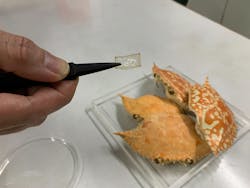Large amounts of crab shell waste are generated daily at seafood processing plants. A visit to one such facility in Northern Iloilo in the Philippines inspired Efren Gumayan to look at converting the waste material into diffraction gratings. A diffraction grating surface with thousands of grooves can split white light into its component colors—and manufacturing them from crab shell waste can help improve sustainability in optical manufacturing.
Gumayan, a Ph.D. student at Ateneo de Manila University (Philippines), led a study in which chitosan, a fibrous substance found in a crustacean’s hard outer shell, is extracted from discarded crab shells to create a bioplastic. This material can then be used to make diffraction gratings—optical components that disperse light composed of different wavelengths into light components (see video and Fig. 1). They’re commonly used in spectrometers and laser systems.
To produce the new bioplastic, researcher Raphael A. Guerrero, a professor and chair of the physics department at Ateneo, says the team first thoroughly washes and dries the crab shells, then crushes them into powder. The chitosan is extracted through a chemical process that eliminates shell components such as minerals, proteins, and color pigments.
The team’s work involves soft lithography, a technique for creating nano devices or 3D structures by molding and embossing an elastomer on a mold. In their study, a silicone cast of a commercial grating was prepared with the original microscopic grooves copied onto a silicone surface. A silicone grating replica was then applied as the mold to create the chitosan gratings (see Fig. 2).In powder form, the extracted chitosan gets dissolved in acid and then poured into a silicone grating mold. Upon hardening, a bioplastic replica is peeled off, with grating structures successfully copied onto the hard chitosan surface.
“In liquid form, chitosan is transparent and can be molded,” Guerrero says. “These features led to our applying chitosan in a grating fabrication process originally designed for silicone.”
The researchers examined the chitosan copies using atomic force microscopy and found the correct groove structures on the grating surface. They also ran diffraction experiments with a laser, which produced the expected beam patterns. “The chitosan gratings worked just like replicas made of silicone,” Guerrero says.
This fabrication process is not subtractive—it does not remove material to create the parts, meaning no chitosan waste is generated. Also, soft lithography makes the process simpler, because it does not require a high-power laser to etch grating grooves on a substrate.
“Our work with soft lithography focuses on the fabrication of transmission gratings,” Guerrero says. “Because of the flexibility of the silicone mold used in the replication process, chitosan gratings with variable groove spacings may be formed.”
This is easily accomplished by stretching the silicone mold before pouring the chitosan solution into it. Concave gratings with focusing ability may also be created by bending the flexible mold.
The chemical process to extract chitosan can be modified to produce bioplastics with different physical properties. And because chitosan also has a higher refractive index than silicone, it could be useful for various optical systems. Guerrero notes that conventional gratings are made of glass and metal films, whereas chitosan gratings are lighter, making systems such as disposable spectrometers possible. Such technology would be less expensive, too, in terms of raw materials because the crab shells are waste products.
“Lightweight and inexpensive spectrometers based on chitosan gratings could be applied as single-use analytical tools for field work,” he says. “Chitosan could be the base material for the spectrometer packaging, and disposing of the biodegradable devices would have minimal impact on the environment.”
Other potential applications lie in the fabrication of waveguides using soft lithography or other techniques for polymers, given chitosan’s high refractive index.
“We have been able to show that chitosan is capable of faithfully replicating nanoscale structures, as well,” Guerrero says. The crab-based bioplastic should be a compatible material for developing diffractive components involving very small elements.
The researchers hope their developments will inspire others considering the use of waste materials for optical applications. It would lead to less solid waste requiring disposal, Guerrero says, as well as improved sustainability in optical manufacturing.
“With proper support from the government and private sector, the chitosan from crab shell waste could become an additional source of income for fisherfolk and seafood plant workers,” he adds.
From here, the Ateneo researchers will continue improving the physical, mechanical, and optical properties of extracted chitosan to make it viable for industrial applications. They hope to optimize the chemical process, as well, to maximize the power efficiency of their chitosan gratings.

Justine Murphy | Multimedia Director, Digital Infrastructure
Justine Murphy is the multimedia director for Endeavor Business Media's Digital Infrastructure Group. She is a multiple award-winning writer and editor with more 20 years of experience in newspaper publishing as well as public relations, marketing, and communications. For nearly 10 years, she has covered all facets of the optics and photonics industry as an editor, writer, web news anchor, and podcast host for an internationally reaching magazine publishing company. Her work has earned accolades from the New England Press Association as well as the SIIA/Jesse H. Neal Awards. She received a B.A. from the Massachusetts College of Liberal Arts.

